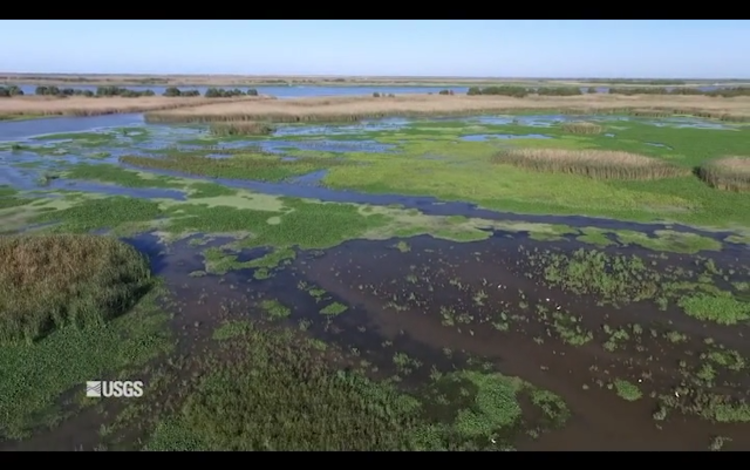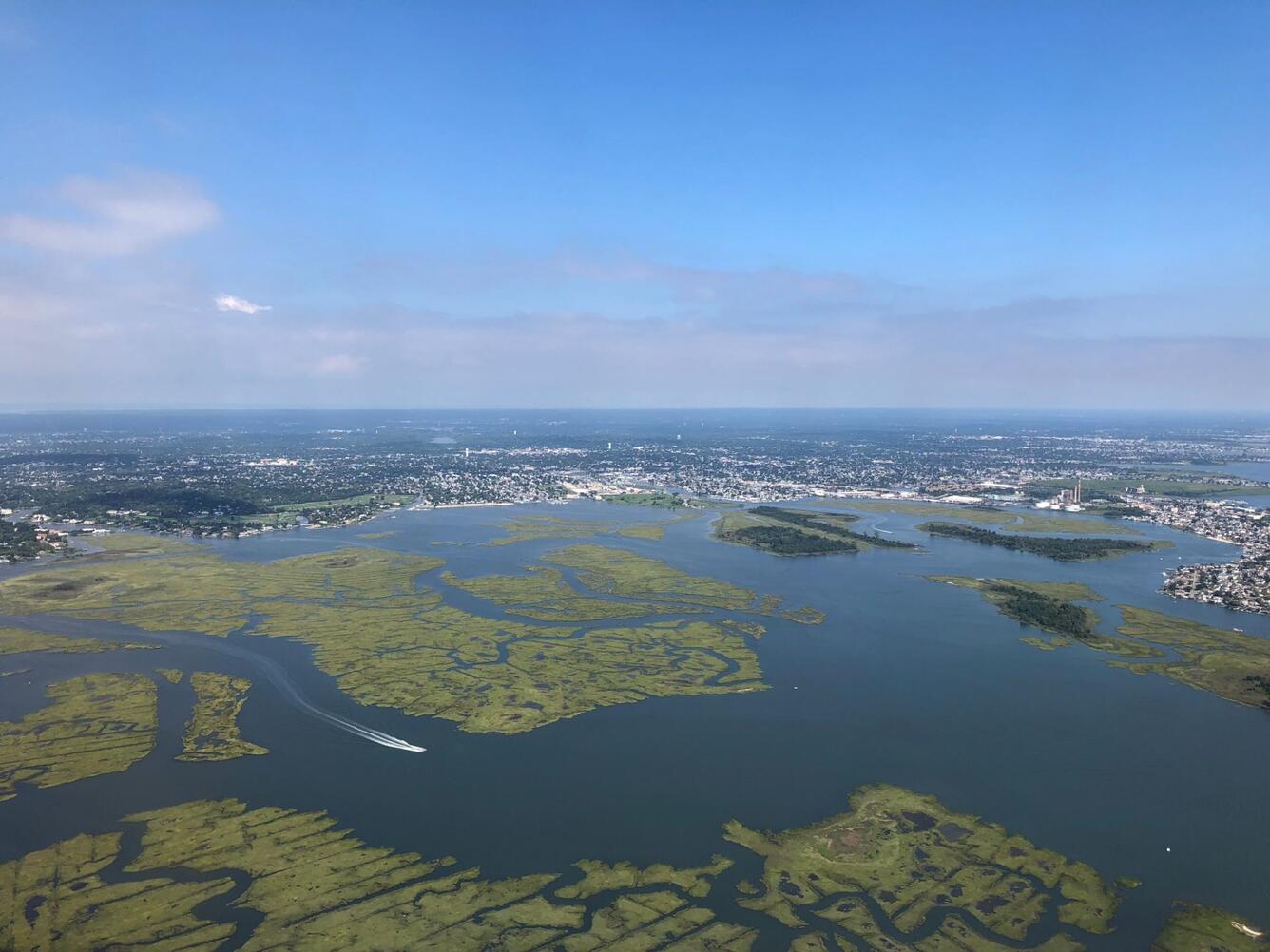Stylized animation showing the shoreline of a wetland that is eroded by waves or currents eating away the sediment along the edge of the wetland. The displaced sediment is then deposited back onto the wetland platform by other waves. When this process happens continually, layers of displaced sediment build up over time, raising the surface of the wetland.
Celebrating American Wetlands Month with USGS Wetland Science
This May, we celebrate our Nation's wonderful wetlands
This month we’re recognizing American Wetlands Month by sharing the important wetland science the USGS Wetland and Aquatic Research Center (WARC) provides to partners along the Gulf Coast, throughout America, and around the world.
What is a wetland?
It’s easy to think that a wetland is simply land…. that is wet. But it's more nuanced than that. A wetland consists of land covered by water - either at or near the surface of the soil – for part of if not the whole year. The amount of water present on these lands helps determine soil conditions and the types of plant and animal communities living in the ecosystem.
What are common characteristics of a wetland?
A wetland can typically be identified as such by the presence of characteristic environments related to water, soil, and aquatic plants.
Water is a critical component in every wetland habitat. In a wetland, soil is either saturated or covered by shallow water for at least part of the year. The quantity and seasonality of water presence helps determine wetland types.
Hydric soil is saturated by water for part of, if not the whole, year, this leads to anaerobic conditions that support the growth of vegetation tolerant of low-oxygen environments.
Aquatic plants known as hydrophytic vegetation are adapted to grow in anaerobic soils resulting from soils being permanent or seasonally saturated.
But...no wetland is the same.
Each wetland varies in its hydrology, plant community composition, soil types, biogeochemical processes, climate, among other environmental factors. They can be different sizes and may be freshwater or saltwater ecosystems. Examples of wetlands studied by scientists at the USGS WARC include salt marshes, bald cypress swamps, and mangrove forests.




Where are wetlands found?
Wetlands occur most anywhere, including every continent besides Antarctica - as long as there is a source of water available, whether it is groundwater or a nearby water body. In the United States, wetlands are found in every state, even Alaska and Hawaii.
What is threatening wetland ecosystems?
Despite their obvious importance, wetlands have experienced degradation and loss from threats like hydrological alteration – via levees and dams, for example - sea-level rise, coastal development, pollution, and even invasive species.
A ghost forest in tidal freshwater forested wetlands of the Sampit River, South Carolina. USGS scientists are investigating the conversion of tidal freshwater forested wetlands - found where freshwater watersheds and estuaries meet - to “Ghost Forests” which result from rising sea levels, salt water intrusion into freshwater wetland habitats, and human activities, like coastal development. Using a large-scale, integrated approach, USGS scientists are studying how these factors affect the ecosystem’s resiliency and capacity for carbon storage, among other ecosystem services. Ultimately, this information will guide decision-making related to wetland restoration, coastal resilience, and carbon sequestration.
Why are wetlands important?
Wetlands are one of the most productive ecosystems on our planet, comparable to rain forests and coral reefs. Often, these serve as a transition zone between land and water, and are important for ecological, economic, and cultural reasons. Wetlands provide habitat to birds, fishes, and other wildlife; buffer coastlines from storms and flooding events; help prevent erosion; and improve water quality by acting as a filtration system. These ecosystems provide recreational opportunities like hiking, kayaking, and bird watching. They also support fisheries and shellfish industries, particularly along the Gulf Coast.
Wetland Science at WARC
Scientists at the USGS WARC investigate wetland structure and function, assess how the benefits these ecosystems provide could be affected by environmental change and human activities, and help inform wetland restoration efforts in key areas, including the Gulf Coast, the Greater Everglades in Florida, and the Mississippi River Alluvial Valley. WARC also provides critical scientific information on the important fish and wildlife species that rely on healthy wetlands for survival.
Mapping Land Area Change in Louisiana
Louisiana has lost more than a quarter of its coastal wetlands, an area about the size of Delaware, since the 1930s. Changes to the Mississippi River and its ability to carry sediment downstream to the Gulf, coupled with sea-level rise, hurricanes, and land subsidence have contributed to the disappearance of these important ecosystems. USGS WARC scientists use historical surveys and aerial and satellite data to monitor the occurrence and rates of wetland change. By quantifying land area change over time, USGS WARC researchers are able to document and assess the short- and long-term effects of natural and anthropogenic factors on coastal wetland loss.
Supporting Restoration Decision Making in the Greater Everglades
One of the largest hydrologic restoration efforts in U.S. history is underway in the Florida Everglades. Starting in the 1880s, extensive agricultural, residential, and commercial development throughout southern Florida disrupted habitat connectivity and water flow and availability to humans and the environment. USGS WARC science informs current restoration projects which aim to help restore the hydrologic flow while balancing the water needs of humans and the Greater Everglades ecosystems. Ecological models are one tool managers can use to evaluate and assess the various restoration strategies. The Joint Ecosystem Modeling (JEM) program, based at USGS WARC, is a partnership among federal and state agencies, universities, and other organizations which continuously develops and applies ecological models and other decision support tools to Greater Everglades restoration project planning. The JEM Sparrow Helper, as an example, helps users understand the impacts of proposed water management scenarios on the Cape Sable seaside sparrow, a federally protected bird species endemic to southern Florida.
Monitoring Coastal Wetland Restoration Projects
To help address the loss of coastal wetlands, federal- and state-funded restoration projects have been implemented across the Louisiana coast. The Coastwide Reference and Monitoring System (CRMS) helps monitor and evaluate almost 400 projects, ranging from sediment diversions to shoreline protection to hydrologic restoration. Considered the world’s largest coastal monitoring program with publicly available data, CRMS is jointly implemented by the state of Louisiana, via the Coastal Protection and Restoration Authority, and the USGS. Scientists from USGS WARC use standardized techniques to collect information about hydrology, soil, vegetation, and land change at 45 of the sites. They also manage the database, analyze data, and ensure the data is available on the publicly accessible website. Long-term, standardized data collection helps evaluate the effectiveness of a restoration project and ensure informed decision-making when it comes to the development and implementation of future restoration projects.
Wetland Science Resources
Dive deeper into USGS WARC wetland science and educational resources!

























